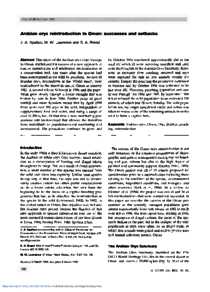Document
Arabian oryx reintroduction in Oman : successes and setbacks.
Identifier
DOI: 10.1046/j.1365-3008.1999.00062.x
Source
ORYX. v. 33, 2, p. 168-175
Contributors
Lawrence, M. W. , Author
Brend, S. A. , Author
Country
United Kingdom.
City
Cambridge
Publisher
Cambridge University Press.
Gregorian
1999-04-01
Language
English
English abstract
The return of the Arabian oryx Oryx leucoryx to Oman symbolized the success of a new approach to species conservation and established reintroduction as a conservation tool. Ten years after the species had been exterminated in the wild by poaching, the first 10 founder oryx, descendants of the 'World Herd', were reintroduced to the desert in central Oman in January 1982. A second release followed in 1984 and the population grew slowly through a 3-year drought that was broken by rain in June 1986. Further years of good rainfall and more founders meant that by April 1990 there were over 100 oryx in the wild, independent of supplementary feed and water, and using a range of over 11,000 sq km. At that time a new monitoring programme was implemented that allowed the transition from individual- to population-based monitoring and management. The population continued to grow and by October 1995 numbered approximately 280 in the wild (of which 22 were surviving founders) and used over 16,000 sq km of the Arabian Oryx Sanctuary. However, in February 1996 poaching resumed and oryx were captured for sale as live animals outside the country. Despite the poaching the population continued to increase and by October 1996 was estimated to be just over 400. However, poaching intensified and continued through late 1996 and 1997. By September 1998 it had reduced the wild population to an estimated 138 animals, of which just 28 were females. The wild population was no longer considered viable and action was taken to rescue some of the remaining animals from the wild to form a captive herd.
ISSN
0030-6053
Category
Journal articles

